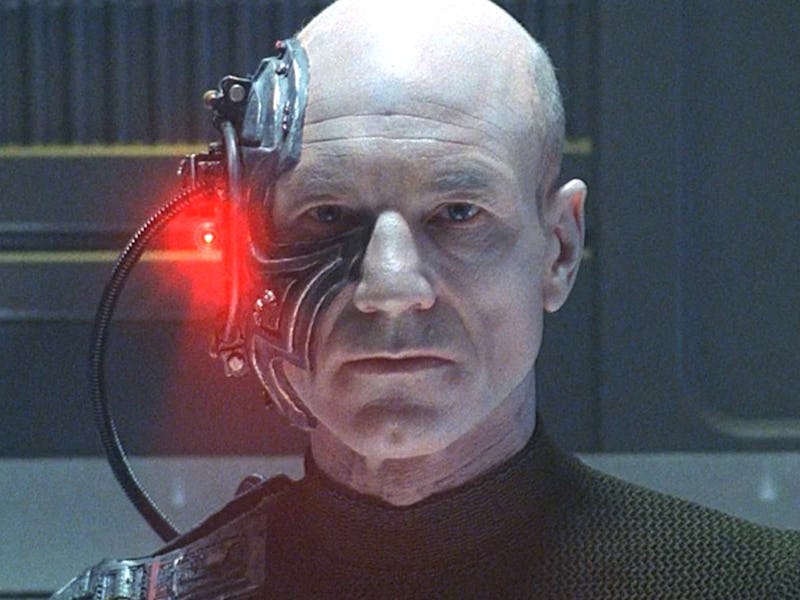Lower Decks finally fixed the biggest Borg plot hole in Star Trek canon
What's up with Borg babies?

Borg drones aren’t born but made.
If you love The Next Generation, or Voyager, or Picard, then you know one of the running themes of the Borg — Star Trek’s most terrifying hivemind villain— is that they take regular people and turn them into part of the Collective.
Anyone who escapes the Borg Collective lives with memories of life before their zombified Borg existence, during it, and after. That’s usually how Borg stories go. Except for Borg babies.
In the first Next Generation episode to feature the Borg, “Q, Who,” we saw Borg babies, implying that some Borg are born. Trek canon’s relationship with Borg babies has been shaky ever since. Until now.
In the latest episode of Lower Decks, Star Trek canon finally tackles the ethical problem of hating the Borg and loving those Borg babies. Mild spoilers ahead for Star Trek: Lower Decks Season 2, Episode 8, “I, Excretus.”
A Borg baby in the TNG episode, “Q, Who.”
Borg babies, explained
In “I, Excretus,” the crew of the USS Cerritos is put through a series of grueling (and hilarious) drills designed to make the junior officers (the Lower Deckers) experience challenging missions usually faced by the high-ranking bridge crew. In one of the holographic simulations, Boimler has to deal with a Borg encounter, in which the computer tells him he has to “resist the Borg.”
Boimler goes into full Star Trek badass mode: firing his phasers, changing the frequency, throwing his phaser at a Borg drone, and sneaking into a secret shaft, all while the score mimics the oh-so-’90s Ron Jones music from the TNG classic, “The Best of Both Worlds.” On Boimler’s first attempt, he sneaks by some adorable Borg babies.
Wait? Borg babies? Were these babies born on the Borg cube? Don’t the Borg assimilate other lifeforms to add other Borgs? Why are their Borg babies? The short answer is the idea that the Borg assimilate organic lifeforms into their collective was actually a very slick retcon from the second Borg episode ever, the previous 1990 episode “The Best of Both Worlds.” In that episode, when the Borg express interest in Jean-Luc Picard specifically, everyone is weirded out. Commander Shelby says, “I thought they weren't interested in human lifeforms, only our technology,” to which Picard counters, “Their priorities seem to have changed.”
This Borg retcon stuck. For the most part, everyone forgot that, when first introduced, the Borg didn’t assimilate organics, just tech. And then, the Borg babies were forgotten, right up until the year 2000.
A Borg baby in a maturation chamber in Voyager’s “Collective.”
The Voyager wrinkle
After the introduction of Seven of Nine — a former Borg drone — as part of the crew of the USS Voyager, Star Trek tried to fix the whole Borg baby conundrum. In the Voyager episode “Collective,” Seven of Nine clarifies that the Borg babies aren’t born but captured and then put into a maturation chamber to accelerate their growth. This explains how Seven was assimilated as a little kid but grew up into an adult Borg. It’s also the origin story of Seven’s surrogate son, Icheb, a former adolescent Borg. With the retcon of the maturation chamber, Voyager reached back to the Borg babies in 1988’s “Q, Who,” and just made it seem like Riker, Picard, and Data were confused.
This additional Borg retcon helped explain the wonkiness of how the Borg deal with assimilating children and provided another layer of Seven’s backstory. But, it didn’t do much for the ethics of blowing up huge Borg ships that — presumably — all have Borg babies on them.
Again, nobody talks about Borg babies in “The Best of Both Worlds” or in First Contact. That is weird, considering we’re all cheering when Borg ships explode, which presumably takes out Borg babies as well.
Boimler rescues the Borg babies.
Lower Decks corrects the Borg baby ethical dilemma
When Boimler first runs the “Borg Encounter” simulation in “I, Excretus,” he doesn’t rescue the Borg babies before leaving the cube ship. This gives him a lower score. So, when Boimler goes back to try and get a perfect score on “Borg Encounter,” the second time, he rescues the Borg babies, which gives him a slightly higher score.
This is a small thing, but it’s pretty huge. The implication here is that within Starfleet, somebody decided that the ideal way a Borg encounter would end is that you would rescue at least some of the innocent victims, specifically the Borg babies. Boimler saving the Borg babies doesn’t give him a perfect score, but as he continues to rescue more drones, this score goes up.
Toward the end of the episode, when Boimler is about to get a perfect score, he casually mentions that he “beat the Borg Queen in a game of chess and taught her empathy.” In this final scenario, Boimler has not only rescued some innocent Borg babies but, perhaps, convinced the Borg to be a little less Borgish.
Although it occurs offscreen (hilarious!), this outcome is easily the most consistent with what Star Trek’s ethical principles ought to be. Throughout all the various series, Starfleet acts like a moral organization, trying to find peaceful solutions. Star Trek has often given itself a pass with the Borg because the Borg are so hard to beat. In First Contact, Picard even shoots several former Enterprise crewmembers who have just been recently assimilated into the Collective.
Lower Decks smartly critiques the dubious Borg ethics of the rest of Star Trek. In First Contact, we were meant to think that Picard had gone too far. But in Lower Decks, the message is clear: The Borg shouldn’t be destroyed; they should be saved. Especially the Borg babies.
Star Trek: Lower Decks has two episodes left in Season 2, which airs new episodes on Thursdays on Paramount+.
This article was originally published on